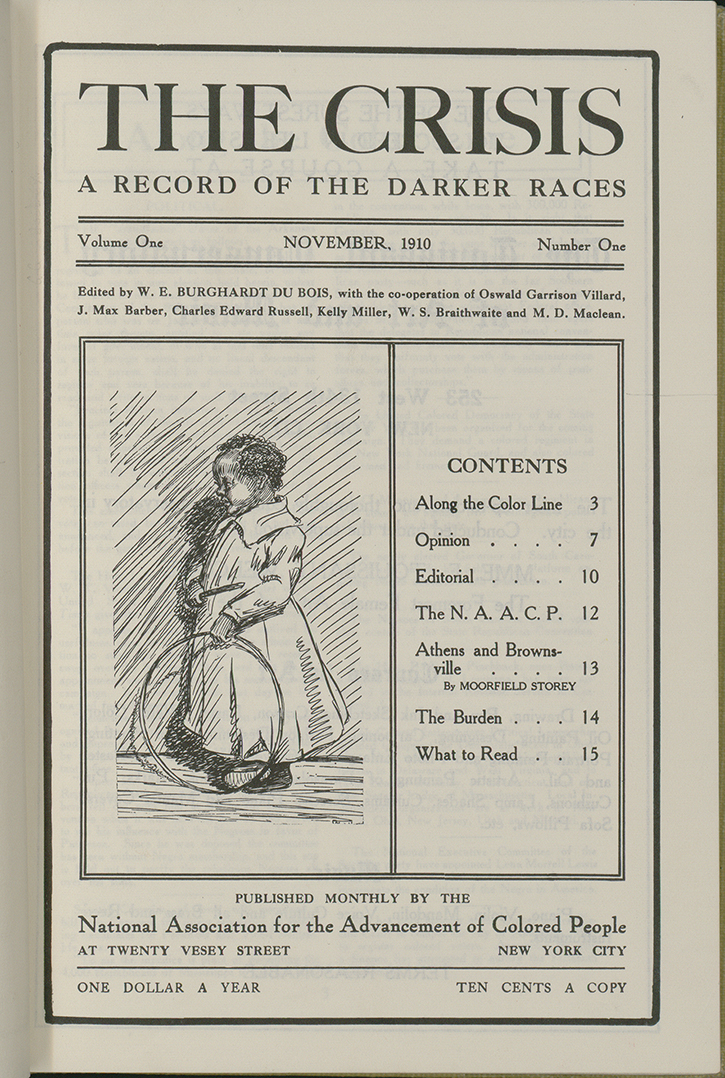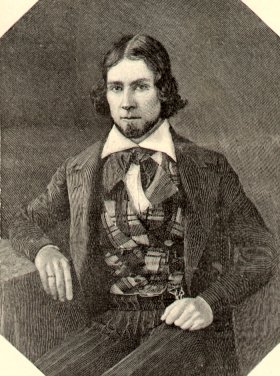|
The Crisis
''The Crisis'' is the official magazine of the National Association for the Advancement of Colored People (NAACP). It was founded in 1910 by W. E. B. Du Bois (editor), Oswald Garrison Villard, J. Max Barber, Charles Edward Russell, Kelly Miller, William Stanley Braithwaite, and Mary Dunlop Maclean. ''The Crisis'' has been in continuous print since 1910, and it is the oldest Black-oriented magazine in the world. Today, ''The Crisis'' is "a quarterly journal of civil rights, history, politics and culture and seeks to educate and challenge its readers about issues that continue to plague African Americans and other communities of color." History The Du Bois era Beginnings and the Du Bois era The original title of the magazine was ''The CRISIS: A Record of The Darker Races''. The magazine's name was inspired by James Russell Lowell's 1845 poem, "The Present Crisis". The suggestion to name the magazine after the poem came from one of the NAACP co-founders and noted white ab ... [...More Info...] [...Related Items...] OR: [Wikipedia] [Google] [Baidu] |
The American Crisis
''The American Crisis'', or simply ''The Crisis'', is a pamphlet series by eighteenth-century Enlightenment philosopher and author Thomas Paine, originally published from 1776 to 1783 during the American Revolution. Thirteen numbered pamphlets were published between 1776 and 1777, with three additional pamphlets released between 1777 and 1783. The first of the pamphlets was published in '' The Pennsylvania Journal'' on December 19, 1776. Paine signed the pamphlets with the pseudonym, "Common Sense". The pamphlets were contemporaneous with early parts of the American Revolution, when colonists needed inspiring works. ''The American Crisis'' series was used to "recharge the revolutionary cause." Paine, like many other politicians and scholars, knew that the colonists were not going to support the American Revolutionary War without proper reason to do so. Written in a language that the common person could understand, they represented Paine's liberal philosophy. Paine also used refer ... [...More Info...] [...Related Items...] OR: [Wikipedia] [Google] [Baidu] |
The Present Crisis
"The Present Crisis" is an 1845 poem by James Russell Lowell. It was written as a protest against the Mexican–American War. Decades later, it became the inspiration for the title of ''The Crisis'', the magazine published by the National Association for the Advancement of Colored People. Composition and publication history Lowell wrote the poem at a time when the United States government was considering the annexation of Texas as a state allowing slavery, which Lowell and others opposed because it would increase power in the South. Further, he worried that the precedent would be set to expand slavery into California and the southwest.Pierpaoli, Paul G., Jr. ''The Encyclopedia of the Mexican-American War: A Political, Social, and Military History'' (volume I), Spencer Tucker (editor). Santa Barbara, CA: ABC-CLIO, 2013: 372. In 1844, John Greenleaf Whittier, a poet actively working for the antislavery movement, asked Lowell to write a poem to inspire others. In a letter to Lowe ... [...More Info...] [...Related Items...] OR: [Wikipedia] [Google] [Baidu] |
The Big Sea
''The Big Sea'' (1940) is an autobiographical work by Langston Hughes. In it, he tells his experience of being a writer of color in Paris, France, and his experiences living in New York, where he faced injustices surrounding systematic racism. In his time in Paris, Hughes struggled to find a stable income and had to learn to be efficient by taking many odd jobs like working in nightclubs and small writing jobs. Eventually, he began to rise to fame as a writer, Hughes began referencing his past struggles regarding abuse from his father where he was divided between the trauma his father endured versus the damage it did to Hughes. Hughes's autobiography exemplifies the obstacles that many African-American artists faced during the early twentieth century in the United States. Background Langston Hughes' childhood was tumultuous. He mainly grew up with his mother due to his father abandoning them in order to seek fortune in Mexico. Because of the color of her skin, Hughes' mothe ... [...More Info...] [...Related Items...] OR: [Wikipedia] [Google] [Baidu] |
Langston Hughes
James Mercer Langston Hughes (February 1, 1901 – May 22, 1967) was an American poet, social activist, novelist, playwright, and columnist from Joplin, Missouri. One of the earliest innovators of the literary art form called jazz poetry, Hughes is best known as a leader of the Harlem Renaissance. He famously wrote about the period that "the Negro was in vogue", which was later paraphrased as "when Harlem was in vogue." Growing up in a series of Midwestern towns, Hughes became a prolific writer at an early age. He moved to New York City as a young man, where he made his career. He graduated from high school in Cleveland, Ohio, and soon began studies at Columbia University in New York City. Although he dropped out, he gained notice from New York publishers, first in ''The Crisis'' magazine and then from book publishers, and became known in the creative community in Harlem. He eventually graduated from Lincoln University. In addition to poetry, Hughes wrote plays and short sto ... [...More Info...] [...Related Items...] OR: [Wikipedia] [Google] [Baidu] |
Jessie Redmon Fauset
Jessie Redmon Fauset (April 27, 1882 – April 30, 1961) was an African-American editor, poet, essayist, novelist, and educator. Her literary work helped sculpt African-American literature in the 1920s as she focused on portraying a true image of African-American life and history. Her black fictional characters were working professionals which was an inconceivable concept to American society during this time Her story lines related to themes of racial discrimination, "passing", and feminism. From 1919 to 1926, Fauset's position as literary editor of ''The Crisis'', a NAACP magazine, allowed her to contribute to the Harlem Renaissance by promoting literary work that related to the social movements of this era. Through her work as a literary editor and reviewer, she encouraged black writers to represent the African-American community realistically and positively. Before and after working on ''The Crisis,'' she worked for decades as a French teacher in public schools in Washingto ... [...More Info...] [...Related Items...] OR: [Wikipedia] [Google] [Baidu] |
Harlem Renaissance
The Harlem Renaissance was an intellectual and cultural revival of African American music, dance, art, fashion, literature, theater, politics and scholarship centered in Harlem, Manhattan, New York City, spanning the 1920s and 1930s. At the time, it was known as the "New Negro Movement", named after ''The New Negro'', a 1925 anthology edited by Alain Locke. The movement also included the new African American cultural expressions across the urban areas in the Northeast and Midwest United States affected by a renewed militancy in the general struggle for civil rights, combined with the Great Migration of African American workers fleeing the racist conditions of the Jim Crow Deep South, as Harlem was the final destination of the largest number of those who migrated north. Though it was centered in the Harlem neighborhood, many francophone black writers from African and Caribbean colonies who lived in Paris were also influenced by the movement, which spanned from about 1918 until ... [...More Info...] [...Related Items...] OR: [Wikipedia] [Google] [Baidu] |
Ida B
''Ida B: ...and Her Plans to Maximize Fun, Avoid Disaster, and (Possibly) Save the World '' is a 2004 children's novel written by Katherine Hannigan. The audiobook version is narrated by Lili Taylor. Plot introduction "Reference from McGraw Hill Reading Wonders Grade 5" Independent Ida B. is home schooled and loves her life, spending a lot of time communing with nature. When her mother is diagnosed with cancer, she faces a lot of difficult challenges. Her days of home school ends, and she has to go to public school. Worse, her parents need to sell part of her beloved orchard for medical bills, which means most of the trees will be cut down. Upset by all the depressing changes around her, she stubbornly decides to separate herself from her parents, mostly spending time with her pet dog Rufus and cat Lulu. But what she doesn't know is that going to Ernest B.Lawson Elementary School with Ms.W will change her life forever. Awards * 2004 Josette Frank Award winner * 2004 ''Publisher ... [...More Info...] [...Related Items...] OR: [Wikipedia] [Google] [Baidu] |
Mary Church Terrell
Mary Church Terrell (born Mary Eliza Church; September 23, 1863 – July 24, 1954) was one of the first African-American women to earn a college degree, and became known as a national activist for civil rights and suffrage. She taught in the Latin Department at the M Street School (now known as Paul Laurence Dunbar High School)—the first African American public high school in the nation—in Washington, DC. In 1895, she was the first African-American woman in the United States to be appointed to the school board of a major city, serving in the District of Columbia until 1906. Terrell was a charter member of the National Association for the Advancement of Colored People (1909) and the Colored Women's League of Washington (1892). She helped found the National Association of Colored Women (1896) and served as its first national president, and she was a founding member of the National Association of College Women (1923). Early life and education Mary "Mollie" Eliza Church was born ... [...More Info...] [...Related Items...] OR: [Wikipedia] [Google] [Baidu] |
William English Walling
William English Walling (1877–1936) (known as "English" to friends and family) was an American labor reformer and Socialist Republican born into a wealthy family in Louisville, Kentucky. He founded the National Women's Trade Union League in 1903. Moved by his investigation of the Springfield Race Riot of 1908 in the state capital of Illinois, he was among the co-founders of the National Association for the Advancement of Colored People (NAACP) in 1909. He wrote three books on socialism in the early 20th century. He left the Socialist Party because of its anti-war policy, as he believed United States participation in the Great War was needed to defeat the Central Powers. Early life and education William English Walling was born into wealth in Louisville, Kentucky, the son of Willoughby Walling, a physician who had inherited much real estate, and Rosalind (née English) Walling. He had an older brother, Willoughby George Walling. His father's family were planters who had held sla ... [...More Info...] [...Related Items...] OR: [Wikipedia] [Google] [Baidu] |
Dusk Of Dawn
''Dusk of Dawn: An Essay Toward an Autobiography of a Race Concept'' is a 1940 autobiographical text by W. E. B. Du Bois that examines his life and family history in the context of contemporaneous developments in race relations. Preceded decades prior by the better-known ''The Souls of Black Folk'' (1903), ''Dusk of Dawn'' focuses on Du Bois's relationship with Booker T. Washington, his reasons for leaving the National Association for the Advancement of Colored People, and a new concept of race. In contrast to Washington's '' Up From Slavery'', a blend of slave narrative and autobiography, ''Dusk of Dawn'' traces the genealogy of the race concept as it affected Du Bois's life. Du Bois elucidates his theoretical writing with personal experiences, and connects those experiences to the larger historical and social phenomena he identifies as central to the function and development of race in the United States. Reviewing the book in 1940, Metz P. Lochard, editor of ... [...More Info...] [...Related Items...] OR: [Wikipedia] [Google] [Baidu] |




